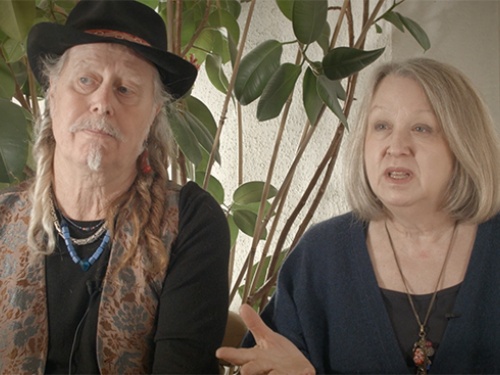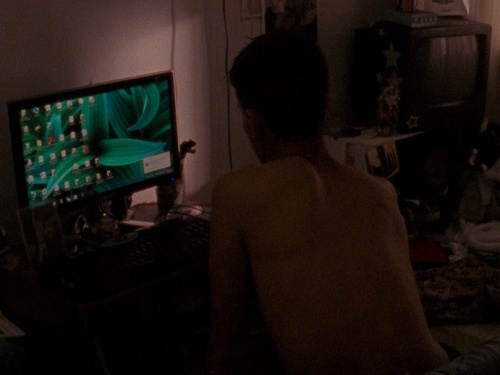Exhibition: An Interview with Liam Gillick
With Joanna Hogg's acclaimed new film Exhibition currently playing in the ICA Cinema, and in advance of her conversation with Henry Bond following the 8.15pm screening on Thursday 1 May, Jo Blair spoke to the film's co-star Liam Gillick for the ICA Blog.
Jo Blair: You've spoken about how when Joanna approached you (in what was a very astute casting decision) that being ‘material’ intrigued you. Could you expand on that please? I’m thinking in relation to your voice, your body and of course your artistic productions which add another layer to this fictional character for those who know your work.
Liam Gillick: As an artist it is important to address the problem of cinema. Cinema embodies many of the potentials and failures of contemporary art in the twentieth century. It has an audience and it has “reach” – but it also has idiocy, repetition and disappointment. I wanted to address some of these things but I have a problem with the “normal” route an artist is supposed to take. Directing others has never interested me. I don’t want to spend my timing ordering people around to get towards a realisation of my vision. When Joanna contacted me I had been thinking of this cinema problem a great deal. It was almost as if she could read my thoughts from a distance. Although we had no time between her request and the start of the shoot, she did suggest that I look at Bresson’s Notes on Cinema before the shooting started. He writes about the actor as mannequin. I decided to take this route. I often cleared my mind completely before scenes and just played them as a body in space. Sometimes I didn’t even listen to the other actors around me – just sensed myself in space. I didn’t think my character would be a good listener so I played him as someone aware of his body who doesn’t hear everything first time—who is hearing everything for the first time—and mishearing some of it.
In relation to that, as someone who has often pursued what might be called parallel practices in terms of producing books et cetera alongside exhibitions, how do you think of your performance in this film? Did you separate it mentally? Has your opinion altered throughout the process? And if you were approached now for other acting roles would you be interested?
I managed to separate by switching off. I would spend a lot of time between takes either sleeping or reading or sitting outside with the technical crew. Between scenes I didn’t think about what had happened or what might come to pass. I didn’t see myself in a creative role. I took time to be in the moment and not construct anything. I enjoyed the process a great deal – but that’s partly because I spent a lot of time watching Joanna thinking and looking. In return I always had a camera close by. I used the camera to turn the lens back onto the process. This is an old trick but it helped me at times when I would otherwise be in danger of slipping into consciousness [sic]. I would work with Joanna again. As for other projects, it would either have to happen the same way she approached me—out of the blue and with risk and conviction—or as part of a collaborative process. I did discover that I have a good memory for myself in space and I can do many many takes of the same scene slightly differently. This was strangely rewarding.
Reviewers have written of the couple in the film being ‘trapped’ in this modernist house, of its rectilinear spaces, and of course the dominant theme of a dysfunctional relationship. But on a second viewing, the images that remained most strongly in my mind were the central spiral staircase—a whorl in the film, in time—the shots of D swimming luxuriantly in the pool, the image and sound of the trees outside with leaves fluttering in the wind, the colours which increase in intensity as the film goes on, e.g. the striking red door/screen. Although it is wonderful that the formal precision of Joanna’s work is lauded, I wonder if these sensual qualities are given, or will be given, the same prestige. And that made me think of the reception of the sensual qualities in your work too. I’m not really sure there is a question here but would you want to comment on that?
The reading of the house by various critics is the one that most intrigues me the most. I didn’t and don’t see the building as stark or inhuman. It is full of colour and reflections. To some extent the house is a kind of oasis. It is a sensual place with a tropical garden. And this is what my character tries to blot out. It is hard to read in the film – but my office doesn’t have a view. The only windows in it are high up which is why you sometimes see me looking up. I can only see the sky – I am not really lost in thought. I lived in the house for most of the time during the shoot. And in fact it is a very compact place. There was barely room to move with all of the crew – even though it was a small team. Living there was deliberate—so I could get used to moving around in the dark—running up and down stairs without thinking about it. Knowing what was in every drawer and closet. It was actually a great place to live – not for the reasons that might strike the casual viewer such as the pool and the luxury. It was a sympathetically designed modernist building. It was a good place to think. An easy place to write and work and sleep.
In Thom Anderson’s essay film Los Angeles Plays Itself he speaks of how Hollywood films have represented modernist homes in more mainstream films. Despite some directors appreciating and living in them, in their films they are the domains of serial killers, pimps, drug dealers et cetera (although recently Anderson commented that 'Now the rule is that gay men live in modernist houses and lesbians live in craftsman houses.’) In Exhibition, just before the sale, D says ‘it’s in the walls’ referring to them recording not only her and H's time and happy memories there as a couple but also the many years the architect lived there with his wife. And then in the final shot a family have moved into the house, with joyful children jumping around. What can we take from this about the aims of modernist architecture of that period and/or its representations?
It is true that the house was originally built for a “professional” couple whose children had grown up. The idea was to create a place of work and thought in the center of a historic area of London. The house is not ostentatious. It is not an oligarch’s parody of American Pyscho modernism. It has quirks and clarity in equal measure. It is also protected from the street – not overtly displaying its interior spaces. The house is from a period where modernism was not connected to lifestyle but to politics. The same principles exist for the design of this house as exist in the best public housing projects of the period. The house is in some ways a “matter of principle”. I decided that for H the reasons to leave the house are that its utopian potential has waned over the years and can no longer carry the hopes of an egalitarian modernist future. He had known this of course when he bought the place with D – but twenty years ago it was a bargain, out of fashion and in poor condition, in my opinion. He must have thought that by restoring the house to its original state that he could absorb some of its potential. But has realized that with time passing the place cannot embody his political desires. The reason the couple never talk about money is that they are ashamed at how much the house is worth. It is not a matter of pride that mid-century modernism has become a fetish and is now parodied in the design of banker’s lofts.
Is it Steppenwolf that H reads to D in bed? I confess I haven’t read it but I was interested in some parallel themes with Exhibition, especially the central character who is disgusted yet fascinated with bourgeois society. He chooses to live amongst the bourgeoisie despite expressing contempt for them. I think the author Hermann Hesse suggested it was the Steppenwolves who maintained bourgeois society. Do you think that is the case nowadays? If so what do you think that implies for artists who may have achieved ‘success’ in living in an interesting, and valuable, property? And also for younger artists or creative practitioners and their aspirations?
I think that the tension between artists and the “enlightened bourgeoisie” is at the heart of a lot of misunderstanding about contemporary art. The history of modern and contemporary art has always been a history of people buying time as much as objects. For me these two characters have always sold time and ideas rather than things. But in the current neoliberal context this is an ideal that has been taken over by the most rapacious and shape-shifting corporations and startups. The house in this case—and the couples decision to move there in the early 1990s—was a stand against the bourgeois surroundings where it stands. They have lost the battle against the genius of the bourgeoisie to co-opt all their various positions and recast them as lifestyle. That’s what H is trying to say to the builder who parks in his space. He is trying to assert that the house is outside the context of elegant Regency houses and Victorian mansions. He can’t understand why no one can see what he sees. For me the Steppenwolf references are definitely there but it is D who is lured towards the lights and pleasure. H has already given up. The Steppenwolf character is split between the man and woman in this case. She carries one aspect of the character and H the other. Together they are the Steppenwolf and this is why they are still together. ■
Exhibition (dir. Joanna Hogg, UK 2013, 105 mins, cert 15) is being shown at the ICA from 25 April. Joanna Hogg will be in conversation with Henry Bond following the 8.15pm screening of Exhibition on Thursday 1 May.
This article is posted in: Events, Film, Interviews
Tagged with: Liam Gillick, Jo Blair, Joanna Hogg, exhibition, Film, interview, artist




